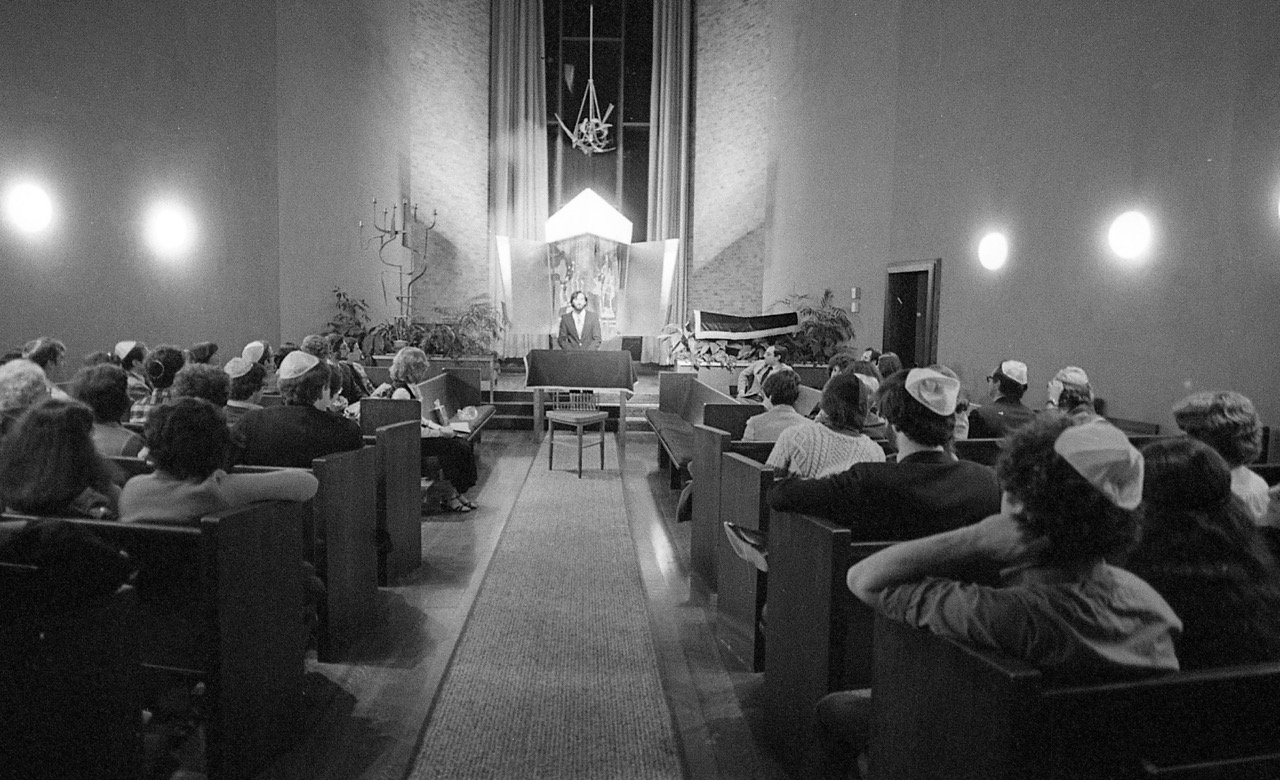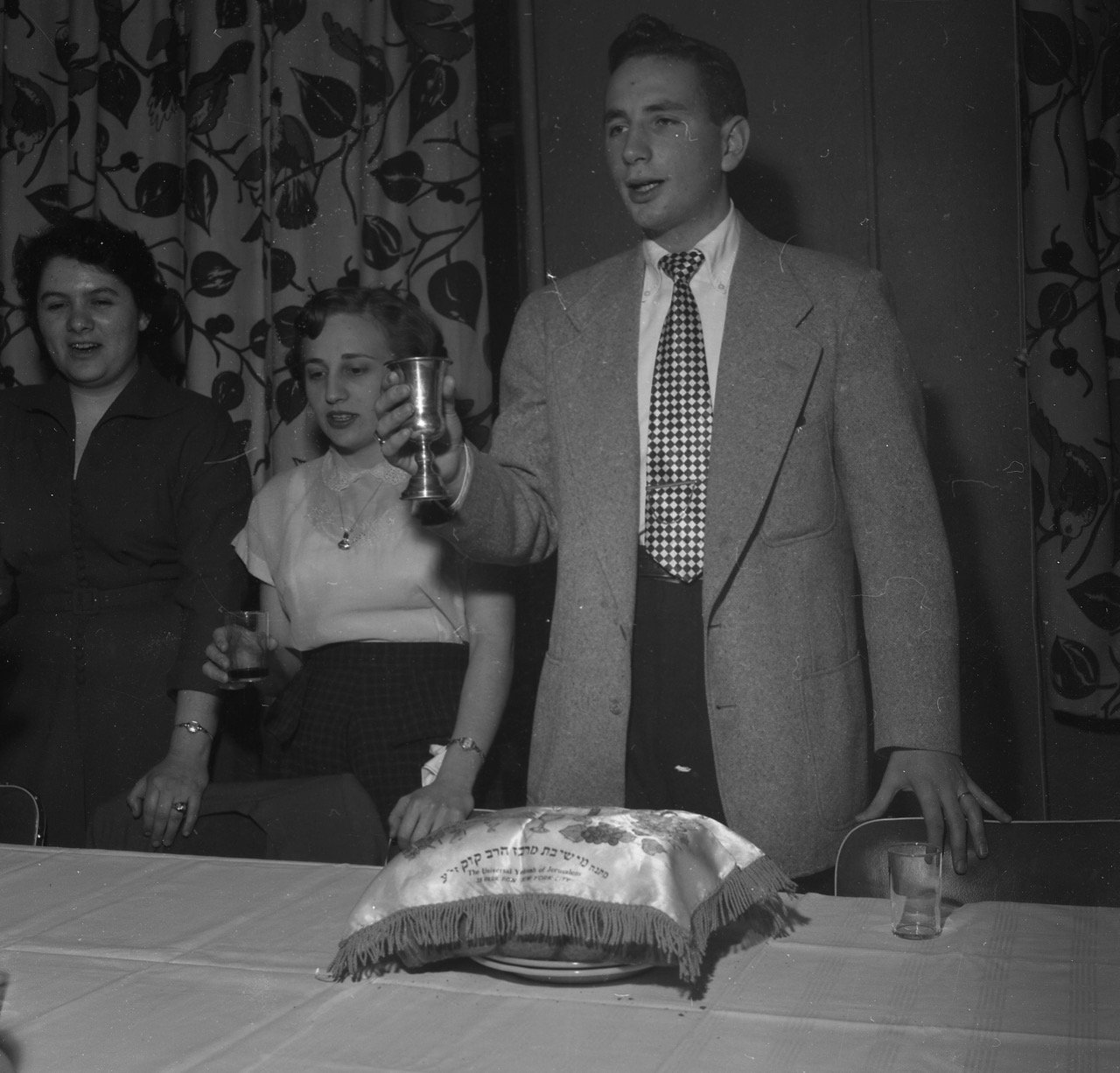
Our History
Photo above from 1980 - Courtesy of the Robert D. Farber University Archives & Special Collections Department, Brandeis University
The following historical timeline of Jewish life at Brandeis was prepared by Isaac Kurtz '18 and Professor Jonathan D. Sarna '75.
1948 - Brandeis Hillel is founded along with the creation of the University. President Abram Sachar notes that the University must search to balance its reputation “for excellence in its studies and research while it also was sought out as an influential center of Jewish learning and communal responsibility.”[1]
1949 - The 6th Lubavitcher Rebbe, Rabbi Joseph I. Schneersohn, sends Rabbi Shlomo Carlebach and Rabbi Zalman Schacter to Brandeis to spread Chabad’s message to college students. They arrive at the university during a Chanukah party and engage students in conversation about Judaism and theology.[2]
1950 - Students debate the “Christmas Tree Question” after a public display of a Christmas tree provokes controversy on campus. The debate highlights questions of religious diversity within public spaces at Brandeis.[3]
Making Kiddush - 1950 Courtesy of the Robert D. Farber University Archives & Special Collections Department, Brandeis University
1951 – Prof. Nahum N. Glatzer is appointed to the Department of Near Eastern & Judaic Studies. Glatzer becomes the chairman of the department and is responsible for recruitment of students and faculty, including Prof. Simon Rawidowicz. The Judaic Studies department works to influence campus life as faculty engage students with their research and learning. [4]
1953 - Brandeis announces the construction of Berlin Chapel as a Jewish and sectarian prayer space. After students protest the decision, President Sachar decides to construct chapels for the Protestant and Catholic communities as well. President Sachar describes the construction of the chapels as the “ideal interfaith experiment, since Brandeis is the first university to provide facilities for groups of lesser number.” [5]
1957 - Rabbi Irving (“Yitz”) Greenberg is hired as the first full-time Director of the Brandeis Bnai Brith Hillel Foundation. Greenberg describes Hillel at Brandeis as an organization that “presents a positive Jewish life as a significant alternative in modern existence, as a framework for self-expression and as an inspiration”. He also announces that “kosher meals are now available at Brandeis for all who want them”. The University purchases new sets of dishes and silverware, but there is not yet full-time oversight (mashgiah) for the kitchen. Greenberg also oversees the construction of the first sukkah on Brandeis’ campus.[6]
1960 – Prime Minister David Ben-Gurion is invited to a convocation at Brandeis. The invitation is part of a plan to strengthen Israel’s diplomatic ties with the United States.[7]
1963 - According to chapel usage statistics, Conservative and Reform Yom Kippur service attendance reaches an all-time high; there is standing room only available in those services. The services are held in Slosberg Auditorium and attract students as well as community members.
Rabbi Axelrad with members of the community - 1971 Courtesy of the Robert D. Farber University Archives & Special Collections Department, Brandeis University
1964 – Rabbi Albert Axelrad is hired as Hillel director; he will remain at the position for 34 years (1964-1999). His tenure is highlighted by his political activism surrounding the war in Vietnam, Civil Rights, the battle to rescue Soviet Jewry, and his effort to build an engaged Jewish community on campus.[8]
1966 – The Waltham Group is founded through Hillel at Brandeis. The group's mission is to involve students in service projects in Waltham and in the Boston community. After its initial meetings in Berlin Chapel, the club expands to become one of the largest and longest running clubs on campus.[9]
1971 - The first annual Jewish Arts Festival hosted by Hillel is held at Brandeis. The festival’s goal is to emphasize Jewish artists and performers. The festival inspires similar events on college campuses across the country. Over the years the event brings such luminaries as Elie Wiesel, Debbie Friedman and Shlomo Carlebach to the campus. [10]
1973 - The Yom Kippur War triggers an outpouring of support from students and faculty towards the State of Israel. Brandeis is the first university to declare a moratorium on fundraising. It encourages prospective donors to purchase Israeli bonds.[11]
1974 - The Reform Group Activities club is created within Hillel. The group is formed out of a sense that “an increasing number of Reform Jews have come to feel that their needs and interests were not being met by the more traditional services”. The group looks to create regular study, service, and social spaces for Reform Jews. It is the precursor for the Brandeis Reform Chavurah (BaRuCH).[12]
1977 - The Student Coalition for Soviet Jewry is formed after the imprisonment of Soviet dissident Anatoly (Natan) Shcharansky. The group becomes the leading force in advocating for Soviet Jewry on college campuses, and its lobbying efforts attract students from over 500 colleges.[13] Sasha Yakir is the “adopted refusenik” of Brandeis Hillel, which also welcomes and runs programs for newly-arrived Soviet Jews in the Boston area.[14]
1987 - The campus struggles with the introduction of pork and shellfish to the Usdan Dining Hall. The absence of pork and shellfish had long been part of the university’s cultural identity as a Jewish institution. The response from the general Jewish community was swift, many charging that the change violated the Jewish community’s trust. Students on campus reacted as well, warning that the university was abandoning its Jewish identity.
Hillel Dance - 1953 Courtesy of the Robert D. Farber University Archives & Special Collections Department, Brandeis University
1987 - The Hillel Theater Group is founded. The group offers open auditions and does not perform on Friday night or Saturday so as to give observant Jewish students the chance to participate. The group's first performance is “Joseph and the Amazing Technicolor Dreamcoat.” [15]
1989- Hassenfeld Conference Center is expanded to become “the largest kosher conference facilities at an educational institution”. Brandeis builds both a kosher meat and dairy kitchen, and places the facilities under the supervision of Rabbi Jacob Mann.[16]
1990 - Rabbi Meir Kahane, an American-Israeli Orthodox rabbi, ultra-nationalist politician, teacher, and writer speaks at Brandeis. His speech meets with large protests outside the event.[17] Five days later he is assassinated.
1991 - Brandeis Orthodox Organization (BOO) is founded. Its goal is to “raise awareness of Orthodox Judaism through speakers, debates, and educational programs.”[18] A year later (1992), the “BOO Beit Midrash” is founded in the basement of Shapiro dorm as a place for studying and learning Jewish texts in an informal context.[19]
1992 - Rabbi Elyse Winick is hired as the assistant director of Hillel. Rabbi Winick is the first female rabbi hired by the University. She returns to her alma mater with hopes of supporting students and engaging them with educational programming.[20]
1993 - The Brandeis University Conservative Organization (BUCO) is founded. The club is “devoted to the exploration, pursuit, and promotion of Conservative Judaism on campus.”[21]
1994 - Shimon Peres speaks at Brandeis in front of a crowd of 4,000 people. He promises a peace agreement to be implemented before the end of the year, and outlines the major points of negotiation with the Palestinians and Jordanians. Protesters call him a traitor and encourage him to hold onto the Golan Heights.[22]
Sukkot on Campus - 1976 Courtesy of the Robert D. Farber University Archives & Special Collections Department, Brandeis University
1995 - Brandeis student Alisa Flatow is murdered in Israel in an Islamic Fundamentalist terrorist attack on a bus traveling to Kfar Darom. Alisa was actively involved in Hillel and the Orthodox community. Her death shocks the campus.[23]
2000- Rabbi Allan Lehmann is hired as Brandeis Jewish Chaplain and Hillel Rabbinic Director (2000-2007). During his time at the university Lehman works to build bridges “between segments of the University's Jewish community, and between the Jewish community and other groups on campus”[24].
2000 - Brandeis is the first campus to host the Orthodox Union’s Jewish Learning Initiative on Campus (OU-JLIC). The program’s goal is to “help Orthodox students navigate the college environment, balance their Jewish commitments with their desire to engage the secular world, and provides avenues for spiritual development and exploration for Jewish students from varied backgrounds, representing a positive, sophisticated and welcoming face for Orthodox Judaism on campus.” Rabbi Todd Berman and his wife, Naomi Berman, inaugurate the program.
2001 – “Chabad at Brandeis” is founded by Rabbi Peretz and Chanie Chein. The house on Turner street welcomes students for Friday night dinners, Jewish holiday programs, lectures, and classes on Judaism.[25]
2004 – Larry Sternberg is hired as the Executive Director of Brandeis Hillel and holds the position for nine years (2004 – 2013). He builds valued relations with students and helps nurture a generation of student leaders. [26]
2009 - The Brandeis Reconstructionist Organization (BRO) is founded as a gathering space for Reconstructionist Jews on campus. The group begins hosting yearly ShaBROtons to bring Reconstructionist students from different universities together.[27]
2011 – President Fred Lawrence announces a communal break-fast for all students following Yom Kippur, which concludes at nightfall. The event quickly becomes a Brandeis tradition bringing students of all faiths together outside of the Student Campus Center (SCC).[28]
2012 – Amid rising tensions surrounding the conversation about Israel on campus, students form Brandeis Visions for Israel in an Evolving World (bVIEW). The group’s goal is to depolarize and improve Israel-related discussions on the Brandeis campus and on campuses across the United States. The group initiates a yearly conference which draws 200 students from over 17 campuses.[29]
2017 - Rabbi Seth Winberg is named Executive Director of Hillel at Brandeis and Senior Jewish Chaplain. Winberg notes that “Hillel at Brandeis is uniquely positioned to have an outsized impact on the Jewish people around the world”.[30]
2021 - As a result of the COVID-19 Pandemic, Brandeis Hillel organizes the first ever passover Seders on campus. [31]
[1] A Host at Last, Abram Sachar; Atlantic Monthly Press 1976 Pg 258
[2] The Rebbe the Life and Afterlife of Menachem Mendel Schneerson Heilman, Samuel C ; Menachem Friedman; ebrary, Inc.; ebrary, Inc c2010 Pg 168
[3] “Christmas Tree Controversy” Justice January 1950 Vol 2 Num 3
[4] 246
[5] “New Chapel Will be Jewish Sponsored - and Sectarian” Justice January 21, 1953
“Student Council Protests Chapel Plan” Justice February 18, 1953
“Plan Simultaneous Building of Three Campus Chapels” Justice October 2 1953
[6] “Greenberg: Judaism On Brandeis Campus” Justice January 13, 1958
“Hillel Conducts Two New Year Sevices” Justice October 2, 1957
“Hillel Plans Program for Sukkos Holiday” Justice October 21, 1957
[7] A Host at Last, Abram Sachar; Atlantic Monthly Press 1976 Pg. 254
[8] “Albert Axelrad” Brandeis Faculty Archives
[9] Brandeis University Archives, Papers of Rabbi Albert Axelrad Box 2 “Brandeis Hillel Waltham Group Origins”, Robert D. Farber University Archives & Special Collections Department, Brandeis University
[10] “Jewish Arts Festival” Justice March 16, 1971
“Jewish Arts at Brandeis” Justice February 19, 1974
[11] A host at Last 257
[12] Brandeis University Archives “Hillel at Brandeis Records” Box 6 “Jewish Life at Brandeis”, Robert D. Farber University Archives & Special Collections Department, Brandeis University
[13] Hillel at Brandeis Records 1963-2009 Box 1 “Program 1985”
[14] “Group Eyes Soviet Jews’ Plight” Justice March 29 1977
Brandeis University Archives “Hillel at Brandeis Records” Box 1 “Hillel Highlights”, Robert D. Farber University Archives & Special Collections Department, Brandeis University
Brandeis University Archives Paper of Rabbi Albert Axelrad Box 2 “Professional Activities Soviet Union Soviet Jewish Teenager Project”, Robert D. Farber University Archives & Special Collections Department, Brandeis University
[15] “Poor Poor Joseph” Justice April 7 1987 Mann started as the mashgiach 17 years earlier
[16] “Brandeis Expands Kosher Kitchen” Jewish Advocate April 27, 1989
[17] “Khane Assassinated 5 Days After Brandeis Speech” Justice November 6 1990
[18] “Two Clubs Founded” Justice April 17, 1991
[19] “Basement Serves as ‘House of Study’” February 9, 1999
[20] “Rabbi Returns to Alma Mater” Justice September 1, 1992
[21] “Senate Grants Charter to BUCO” Justice February 8, 1996
[22] “Peres Promises Practical Peace Plan” Justice February 8, 1994
[23] “Alisa Flatow, Friend, Devoted Jew” Justice April 11, 1995
[24] “Shalom, Rabbi Lehmann” Justcie May 1, 2007
[25] “New Jews on Block open door to Brandeis” Justice March 18th, 2003
[26] “Hillel director departs” Justice October 22, 2013
[27] “A Fresh Take on Faith” Justice March 10, 2014
[28] “The Katzwer’s Out of the Bag” Hoot October 14, 2011
[29] “Lawrence, panel open bVIEW” Justice January 29 2013
[30] “Rabbi Seth Winberg named Executive Director of Hillel at Brandeis” Brandeis Now May 21, 2017
[31] “Jewish students will make history at Brandeis this Passover” Brandeis Now March 15, 2021




